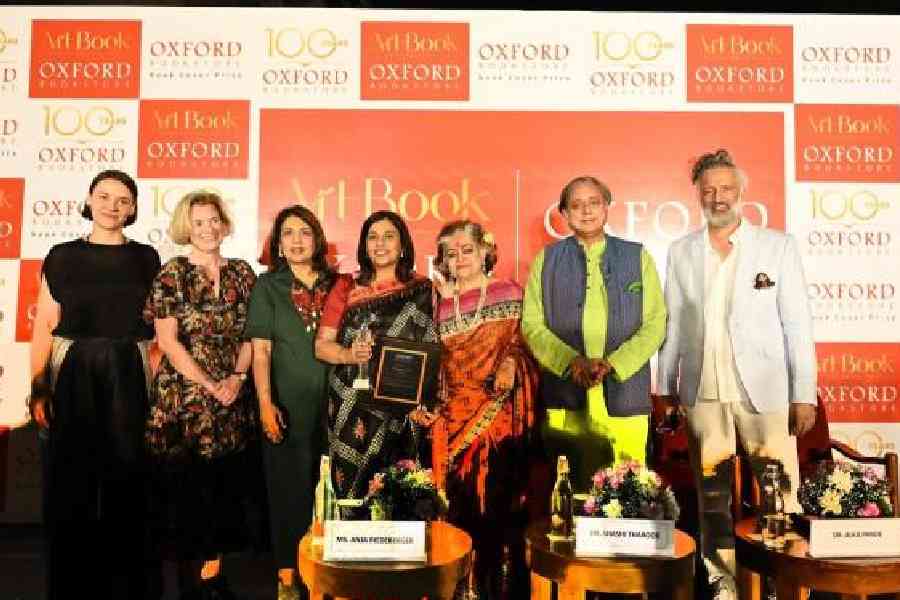The Oxford Bookstore Book Cover Prize 2025 win has been sweet for Devangana Dash — after being longlisted several times, she won it this time around. The Delhi-based multi-disciplinary designer and educator won the prize for Charu Nivedita’s Conversations with Aurangzeb: A Novel. In a tete-a-tete with Dash, she talks about the joy of collaboration, her take on AI and more.
You have been longlisted four times for this award and you got lucky on the fifth attempt. How sweet does it make the win?
I’ve been longlisted four times and shortlisted twice, so yes, the winning feels especially sweet. It’s always heartening when your work is recognised, and when the effort, skill and problem-solving that go into each project are acknowledged — and, in this case, celebrated. I’m grateful for platforms like the Oxford Bookstore Book Cover Prize that make the literary and design process more visible and valued. I received this award not just as an honour, but as a kind of personal milestone — a quiet reward to myself for a decade-long practice in book design, and for staying with the work even when it’s challenging.
The jury was very appreciative of your work.
The esteemed jury was incredibly encouraging, and the award ceremony sparked some thoughtful conversations around book design — something I truly appreciated. It was heartening to hear that Conversations with Aurangzeb had strong support within the jury, and Shashi Tharoor’s mention of it felt especially meaningful. Artist Samar Jodha acknowledged the beauty and complexity of collaboration, and the creative challenges we all navigate when it comes to client approvals and the back-and-forth of design. Alka Pande warmly appreciated my reflections on the design process and spoke generously about the evolving diversity in publishing design today. It felt like a room full of people who genuinely value the craft.
The Charu Nivedita novel gives fresh focus to Aurangzeb. How challenging was it to design the cover?
The cover was designed much earlier, in 2024. The charged response to the subject definitely made it a challenging brief, but also an exciting one. When you’re dealing with a figure like Aurangzeb, whose legacy is so polarising, the responsibility of representation becomes even more layered. But since this was a work of fiction, it offered me room to interpret rather than assert. The idea was to lean into the ambiguity. The narrative itself didn’t seek to give definitive answers, and I wanted the design to reflect that incompleteness. That’s why I chose a silhouette — an evocation of the emperor’s spirit, rather than a literal or realistic portrait. The cover, like the text itself, avoids glorification or condemnation and instead invites conversation, curiosity and interpretation.
Take us through your design process for the book cover.
The design was inspired by the optical art style, which allowed me to create a sense of intrigue and ambiguity around the silhouette of the emperor. One of my early responses to the brief was a stark black-and-white optical illusion, where Aurangzeb’s presence was almost hidden within the pattern, suggesting the idea of fragmented identity and contested legacy. But for print viability and to elevate the visual appeal, I evolved the artwork into something more vivid. I chose rich jewel tones like ruby red and emerald green, which not only worked better in print but also subtly referenced the idea of royalty and opulence. These colours helped create a striking presence while keeping the figure enigmatic.
How important is this recognition in the face of AI-driven technology?
Such recognition reaffirms the value of dialogue, debate, rejection, and those unexpected, serendipitous moments that shape creative work. It brings the human back into the centre of the process, where intuition, empathy, and context matter just as much as efficiency. More power to initiatives like design awards that celebrate the craft of bookmaking and offer visibility to the design process, which often goes unnoticed. This isn’t about being anti-AI; it’s about continuing our conversation with AI. It’s a tool, not a replacement and platforms like this are important reminders that creative work thrives on sensitivity, complexity and human connection — qualities that can’t (yet) be replicated.










